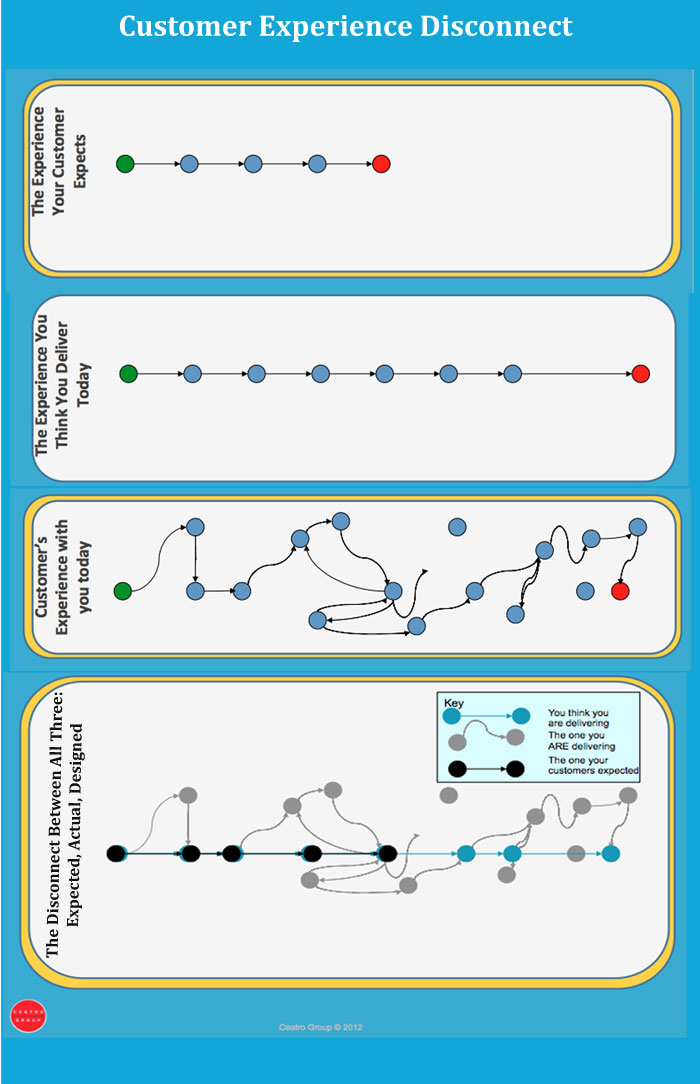At Ceatro Group we are big on the real customer experience.
The real customer experience is the one your customer actually has, whether it is the one you think is happening or the one you designed for them. We think it is essential that organizations understand and monitor both if they have any hope of getting the experience of the Whole Offering right.
To that end, we spend a lot of time documenting the real customer experience for our clients as well as documenting the one they designed (or, as the case usually is, the one they didn’t design). We also encourage our clients, and any company we have an experience with, to not think of one customer’s bad experience as an anomaly (“oh, it just happened that one time. That is not the customer experience for most of our customers.”) because it probably isn’t an anomaly. That customer just cared enough or was upset enough to tell you about it.
Today, I had an experience with Store X, a large department store chain, that should have taken 10 minutes max and took 54 minutes. The call center agent told me that another woman called in right before me with the same last name and with the same issue so I know I am not alone in this.

Let’s look at my experience today in terms of the typical Customer Experience Disconnect (right):
Context: I have 3 pairs of exercise socks that I love. I got them on sale somewhere and haven’t been able to find them again in nearby stores. Last week I decided I’d go online and buy them in bulk. Great exercise
socks are hard to find! I’m a to-do list person so I put it on the personal to-do list and watched it sit there
all week. I decided this morning, Sunday, that I would knock of a few items before I got the day started.
1. The Experience Your Customer Expected
- I expected this to take 5 – 10 minutes. I was going to:
- find the sock’s sales tag that I had saved (1 minute)
- write down the item numbers (15 seconds)
- get my credit card and sit down at the computer (1 minute)
- search for the socks and find the best price (3 minutes)
- go to the site with the best price (10 seconds)
- choose the colors and size (if necessary) I want (2 minutes)
- execute the purchase (2 minutes)
- cross it off the to-do list (5 very satisfying seconds)
- get on with me day
2. The Experience Store X Thinks It Delivered
I don’t know actually know the experience they think they delivered because I’ve never worked with them but I can make an educated guess from working with companies on this problem for so long. They likely think:
- The experience starts once the customer gets to Store X’s site (and not before)*
- Customer either lands on the exact item or searches for it (2 minutes)
- Customer sees options and makes selections (2 minutes)
- Customer goes to shopping cart, reviews order, and proceeds to purchase (1 minute)
- Customer enters addresses and confirms shipping (2 minutes)
- Customer enters credit card information (1 minutes)
- Customer completes transaction (30 seconds)
- Customer sees confirmation screen and later receives an email (1 minute)
*So, we are already a bit disconnected, right? The company’s version of my customer experience starts at my 5th step (go to the site with the best price). It doesn’t include my context or the steps I have to take outside of their world to get to that point. Though we don’t know what Store X really thinks, this is typically what we have seen at organizations that talk about the customer experience they designed – it has tight boundaries that are different than the customers.
3. The Customer’s Experience with You Today (the real experience)
Additional steps from what I expected in maroon text
- find the sock sales tag that I had saved (1 minute)
- write down the item numbers (15 seconds)
- get my credit card and sit down at the computer (1 minute)
- search for the sock and find the best price (3 minutes)
- go to the site with the best price (10 seconds)
- best price was not obvious in the search results so went to 4 sites trying to get the best price (5 minutes)
- first site I tried to buy from didn’t have inventory so went back to search results (2 minutes)
- go to Store X’s site and found out they were having a sales – great! (20 seconds)
- choose the colors and size (if necessary) I want (2 minutes)
- execute the purchase (2 minutes)
- receive an error telling me that one of the items I selected was out of stock and I needed to select again (15 seconds)
- selected again and reentered credit card information (1.5 minutes)
- receive an error telling me that another one of the items I selected was out of stock and I needed to select again (15 seconds)
- selected again and reentered credit card information (1.5 minutes)
- receive an error telling me that another one of the items I selected was out of stock and I needed to select again (15 seconds)
- selected again and reentered credit card information ( 3 minutes)
- initiated an online chat session asking for help understanding the inventory before I placed the order again (4 minutes)
- online agent confirms there is inventory and tells me to call the call center (2 minutes)
- tell her I don’t want to call call center, can’t we do this online since I’m almost done? (1 minute)
- she said it looks like the web site doesn’t have the updated inventory so I need to call (2 minutes)
- I ask her to pass on feedback about my bad experience and the fact that a stocking error came after I finished the transaction (instead of before). (30 seconds)
- I call the call center and wait for assistance (4 minutes)
- a nice agent helps me place the order from scratch including my address, etc (15 minutes)
- while she is doing this I write out 5 thank you cards, pay two bills, and start reading the Sunday paper
- the total is not the same as the total online so we have to troubleshoot the order (5 minutes)
- we review the order out loud (2 minutes)
- order complete
- cross it off the to-do list (5 very satisfying seconds)
- get on with me day
I don’t need to take you through the last step: the disconnect between what I expected, what Store X thought they delivered, and what actually happened because the pure volume of items on the task list demonstrates the disconnect. I went through 20 more steps than I expected and 21 more than we think Store X thought I’d have to go through and the time was exceptionally longer than either of us expected. Let’s look at the impact of something like this can have:
- I’m surely not getting to three other things on this morning’s to-do list
- We didn’t talk about emotions I had and decisions I made during that experience but you can imagine it was frustrating, I felt my time was wasted, I considered other vendors (but the price was really good at Store X so I stayed), I may be too frustrated to purchase from them again, and I am surely going to make a few remarks to friends about Store X’s awful online process
- I took 5 minutes of an online agent’s time which probably equals $3 – $7 dollars and I took 22 active minutes of a phone based agent and 4 minutes in the queue which probably equals $15-$30 depending on call volume, costs, etc.
- I spent $49.00 in socks and $7.95 in shipping
- Bad customer impression + bad word of mouth marketing + service costs – customer spend = a loss for Store X on so many levels
It isn’t that easy to calculate the impact of a poor customer experience but it isn’t too hard either. Experiences like this happen so many times a day. It is imperative that organizations start monitoring the real customer experience, and its permutations, just as it would other critical business processes. If Store X wanted to see this experience I had it could: it could see it in data from its web site and then its call center attached to my credit card number or email address, it could pick it up from the CRM system its call center agent types into (if she is trained to record this kind of thing,) it could monitor it in other forms listening and research periodically, and so on.
Just acknowledging that the customers’ real experience is different from the one it thinks it is giving is a perfect first step.
*Thanks to the ridiculous amount of spam, we have shut down the comment area on all of our blog posts but we still want to hear what you think. Email us at info@ceatro.com
______________________________________________________________________________________
Ceatro Group is a research and consulting firm that helps organizations understand people better and design and/or improve
customer, employee,and partner experiences and underlying operational processes in order to get better business results.
ceatro.com +1-617-338-4535 info@ceatro.com
________________________________________________________________________________________

